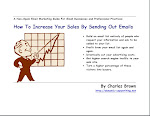Freelance Copywriter Secrets: Unleash the Awesome Power of Testimonials (Part 3)
Posted by Charles Brown at Wednesday, September 20, 2006freelance copywriter, copywriting tips, white papers, rainmaking tips
This article is part 3 in a series entitled Unleash the Awesome Power of Testimonials. In part one, we discussed how testimonials can create credibility and trust, they are evidence you use to bolster your claims regarding your product or service. And we also discussed how testimonials make use of the persuasion technique, social proof, which causes us to tend to model our behavior after the actions of others.
In the second article, we discussed how even complimentary customer feedback is seldom in a form that is very useful as a testimonial. Usually the feedback is long and takes much too long to get to the point. For this reason I suggested editing and calling the customer back to ask if you can shorten or abbreviate their words. Then read the edited version of their own words back to them and ask for their approval.
Once you have their approval, you are good to go and can use that testimonial in your ads, on your web site, in your mailings, brochures and any other informational piece you put out.
Now we come to the question of what should a good testimonial look like? In other words, is there a pattern or formula that can be used in the editing process to turn a customer’s complimentary feedback into a strong and powerful testimonial? Yes there is.
Here are the elements of a good testimonial:
- A Problem. The testimonial is about how you solved a problem for someone. You are the knight in shining armor who came to the rescue of the, er client in distress. But the testimonial must show the distress vividly enough for a reader to be able to relate to the problem your client had before you came to the rescue.
- A Main Character. A testimonial is written in the first person from either your client or a key player within the client organization. If the “main character” is an organization it is still advisable to involve the perspective of the key player(s) so your reader can relate to them as human beings.
- A Distressed Emotional State> Not only must your key players have experienced a problem, your client had to feel pain caused by the problem. The emotional words can be, “anxious,” “worried,” “bewildered,” “panic,” etc. But there must be an emotion that is expressed so the reader can relate to your client’s pain.
- A Desirable Result. The testimonial has presented a problem, the “main character” whether that is a person or an organization, and the pain the key player(s) felt as a result of the problem. Now the reader needs to see a positive outcome that came about because of your actions. Your product or service had to be the catalyst that directly brought about a desirable result.
- A Positive “After” State. The problem is solved, the pain is gone, now how have things changed? Can you demonstrate the desirable result you listed above with new numbers, new profits, new customers. The key to this step is to make the desirable result quantifiable in some way. It has to do more than give the reader a “happily ever after” conclusion.
This format is your objective when editing a client’s positive feedback, but don’t become a slave to it. In other words, don’t stretch your client’s words to the point they no longer feel the testimonial came from them.
Moreover, always be aware that some of the feedback you get will be just fine as is, without any need to edit on your part. When that happens take it like the blessing it is and run with it.
Testimonials can do more to make your ads and marketing materials come alive for a reader than any other tool. This is why I said in Freelance Copywriter Secrets: Unleash the Awesome Power of Testimonials (Part 1) that if you took away every copywriting technique we had to work with, except testimonials, freelance copywriters could still write strong, persuasive ad copy and marketing materials for my clients.
freelance copywriter, copywriting tips, white papers, rainmaking tips



0 comments:
Post a Comment